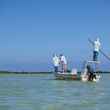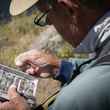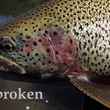I’m in a hotel room in Galveston, Texas. A thunderstorm is keeping me from saltwater fishing, but I’m entertained anyway. I’m holding a book published in 1907 titled The Use of the National Forests.
I’ve decided to read the whole book in one night based on its enticing introduction:
“To the Public: Many people do not know what National Forests are. Others may have heard much about them, but have no idea of their purpose and use. A little misunderstanding may cause a great deal of dissatisfaction.”
How real those words ring today. I bet that’s why Jim Caswell brought the book from his home state of Idaho, public lands percentage 61, to Texas, public lands percentage 2. Caswell is the Bureau of Land Management’s former national director. He’s also the Clearwater National Forest’s former forest supervisor. He knows plenty more than a thing or two about public lands. He held the little, old, red book in one hand and a big, new, green book in the other hand during his keynote dinner speech and said,
“This is why we are where we are today. We’ve lost perspective. We’ve lost the people.”
Caswell’s comments speak volumes. So do his props. The skinny red one is 42 pages. The fat green one, The Principal Laws Relating to Forest Service Activities, published in 1993, is 1,163 pages. Caswell loaned me both for the night, but I only plan on reading one. The thick binding keeps me from cracking the cover on the green book, but I wholeheartedly eyeball the red read. It’s the why behind the establishment of public lands where I live.
I grew up in the West. I work in the West. Public lands are part me of personally and professionally. Public lands are where I play. Public lands are where I work. I’ve always been aware of public lands and I value them with sincere gratitude. They are the one certainty this Western girl knew would never expire.
“I said, ‘It will never happen,’ for a long time, but now I’m not so sure,” Caswell says. “Will it go anywhere? I’m not sure.”
I’m not so sure either and I should have seen the warning signs during my first TV contract as a general assignment reporter two decades ago. I clearly remember covering the closure of the Forest Service office in St. Anthony, Idaho, population 3,356. in 2000.
The logging town was already declining when the feds combined Caribou and Targhee National Forests. Rural offices closed, including the one in St. Anthony, and staff consolidated in the central location of Idaho Falls. Idaho Falls is small by city definition, but much larger than the ag and timber town 45 minutes north.
Green trucks and brown uniforms disappeared in St. Anthony, so did jobs and people. St. Anthony had 71 fulltime Forest Service positions before consolidation. That staff went from being local neighbors you chatted with at the grocery store, to employees in a big-city building down south where you waited in the lobby to possibly to talk with the guy you used to bump shopping carts with on aisle 12.
I’m sure the closure story I covered in Idaho mirrored closures and consolidations across the country. Federal budgets were drying up long before states started volleying for land transfers. I knew the money was going away, but what I didn’t pick up on back then was what those closures meant to communities beyond jobs. Sure it meant payroll lost, but it also meant presence lost.
“We’ve lost our public support. We’ve lost our constituency,” Caswell says. “People do not go to battle for us anymore. They’ve lost confidence in us and rightly so in many cases.”
Presence lost doesn’t have to be permanent. Not if Garth Smelser has anything to do with it. He’s the new forest supervisor for the Caribou-Targhee National Forest. He took over August 2014. He’s post-consolidation and he’s young by agency standards. He didn’t have to ride out the relocation saga back in the day and he never lived in St. Anthony. The Idaho Falls location is all he knows, but he’s aware of presence lost.
“Presence has to be the most important thing. Through increased presence, we get greater understanding. Understanding brings relevance, which leads to advocacy,” he says. “We do have that danger of losing a generation that even cares. If we don’t help them learn to love public land, why should we expect them to take care of it?”
I haven’t ran into Smelser at the grocery store yet, but we talk often. We talk about our little kids loving outside. We talk about getting everyone’s kids outside. Those are personal, friendly talks. We talk about permits. We talk about presence. Those are professional talks and they can get heated, but end productively.
“Presence is key to many agency problems,” he says. “It is the realization that we live here too. If I can be present with people in my uniform having a civil and respectful conversation, I create dividends that I don’t even know are coming down the road. Even over contentious issues, they’ll remember I cared about their opinions.”
Smelser wants the presence of public lands back and so do I. Caswell wants it back too. Without presence, public lands lose relevance. Public lands lose priority. Without presence and without priority, there is no reason to fight for something no one is paying attention to.
“If we lose our public land heritage, we’ve lost a lot for a long, long time,” Caswell says. “Yeah, there are some rules and you need to be a responsible adult, but by in large, it’s open and you can do what you want. For that reason, we have to protect public lands. We have to keep them public. They are worth fighting for.”
































Comments